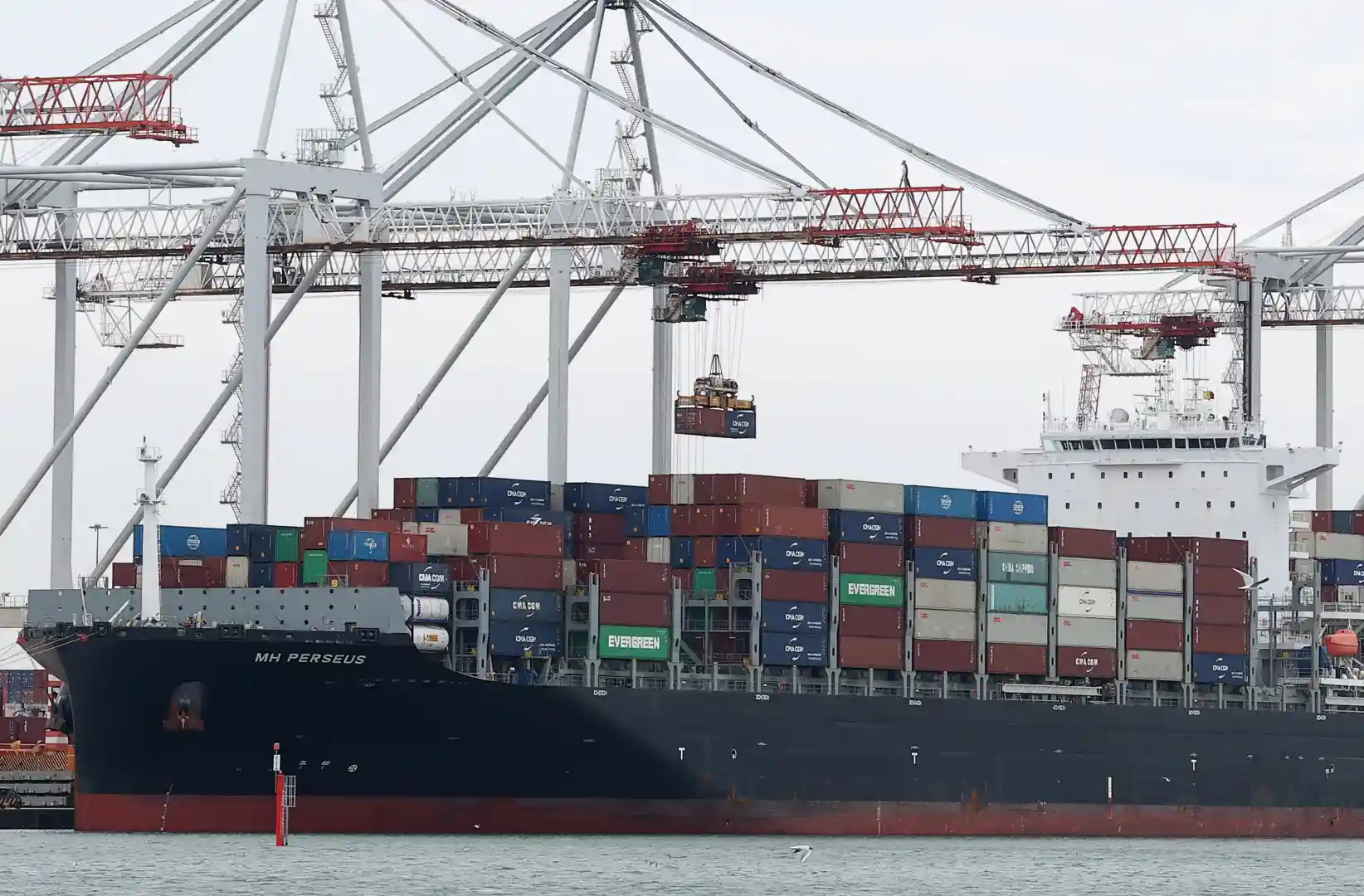The British economy has hit a snag, contracting by a notable 0.3% in April 2025, a performance worse than many economists had feared. This unexpected dip, following modest growth in the preceding months, signals growing challenges for the UK, caught between the escalating global trade tensions ignited by Donald Trump’s “liberation day” tariffs and persistent domestic economic headwinds. Figures released by the Office for National Statistics (ONS) paint a stark picture of businesses cutting jobs and rethinking investment plans amidst a climate of uncertainty.
The contraction, the steepest monthly drop since October 2023, surprised City economists who had forecast a more modest 0.1% decline. This development comes as a significant blow to Chancellor Rachel Reeves, who just days prior had unveiled her government’s ambitious three-year spending review, aiming to kickstart growth and fund crucial public services. The latest data, however, underscores the formidable task ahead for the Labour government as it grapples with a volatile global economic landscape and complex internal pressures.
The Shadow of the Tariff War: Trump’s ‘Liberation Day’ and its Global Ripple Effect
The most striking revelation from the ONS report was the dramatic impact of the new US tariffs. Liz McKeown, an ONS director of economic statistics, pointed directly to Donald Trump’s “liberation day” tariffs, announced at the beginning of April. “After increasing for each of the four preceding months, April saw the largest monthly fall on record in goods exports to the United States with decreases seen across most types of goods, following the recent introduction of tariffs,” she stated.
What are these ‘Liberation Day’ Tariffs?
The phrase “Liberation Day” tariffs, coined by President Donald Trump, refers to a new, aggressive trade policy designed to reshape global trade dynamics. This policy features a two-tiered tariff structure:
- A baseline 10% tariff applied universally to imports from almost all countries, with notable exceptions for Canada and Mexico.
- Additional country-specific “reciprocal” tariffs, which are imposed based on what the US administration deems as unfair trade practices by individual nations. These can reach as high as 25% or more on specific goods.
For the UK, the re-imposition of such tariffs under a potential second Trump presidency has been a looming concern. The recent agreement between the US and UK had seen some tariffs removed (e.g., UK’s retaliatory 20% on US beef) and new tariff-free quotas for certain goods. However, the latest escalation indicates a shift, with the US committing to allow only a quota of 100,000 UK automobiles to enter at a reduced 10% tariff rate, compared to the pre-Trump rate of just 2.5%. While the UK had hailed some of these previous arrangements as wins, the broader reintroduction of tariffs signals a protectionist stance that inevitably impacts global trade flows.
A Direct Hit on UK Exports:
The immediate consequence for the UK has been a significant decline in its export performance to the United States, a critical trading partner. The US is a major market for a diverse range of British goods, and sudden tariffs act as a tax on these exports, making them more expensive and less competitive for American buyers. Businesses, facing higher costs and reduced demand, are forced to scale back, impacting production and, inevitably, employment. This ripple effect was clearly visible in April’s figures, reflecting how quickly changes in international trade policy can translate into domestic economic pain. Companies that might have brought forward sales in February and March to preempt these tariffs are now feeling the squeeze.
The Automotive Industry: A Key Casualty:
The manufacturing sector, which declined by 0.6%, was particularly hit by a reduction in car production. This downturn is “most likely in response to the US 25% levy on auto imports,” as the ONS noted. The UK automotive industry is a vital component of the nation’s economy, contributing significantly to GDP and providing highly skilled jobs across a complex supply chain. The industry has been grappling with various challenges, including the shift to electric vehicles (EVs), intensifying global competition, and post-Brexit trade complexities. A 25% tariff on car imports into a major market like the US adds immense pressure, forcing manufacturers to reconsider production levels and potentially jeopardizing future investment. This directly affects thousands of workers and their families, as car manufacturing jobs are often well-paid and clustered in specific regions.
Trade wars and tariffs are not new phenomena, but their impact can be devastating. Historically, measures like the Smoot-Hawley Tariff Act of 1930 are cited as exacerbating global economic downturns, highlighting how protectionist policies can shrink the overall economic pie, leaving no true winners. The current tariffs contribute to global supply chain disruptions, increase prices for consumers, and foster an environment of economic uncertainty, which often leads to delayed investment and cautious business decisions.
Domestic Headwinds: Taxes, Housing, and a Shifting Labour Market
Beyond the global trade skirmishes, the UK economy also faced significant pressures from domestic policy changes and inherent market dynamics.
The Burden of Higher Taxes on Businesses:
The ONS figures also “underscored concerns that an increase in employer national insurance contributions would harm the UK’s growth prospects.” In April 2025, the UK government implemented a significant rise in National Insurance (NI) contributions for employers. The employer’s NI contribution increased from 13.8% to 15%, alongside a reduction in the threshold for contributions. This translates directly into higher operational costs for businesses, particularly for labour-intensive sectors and small and medium-sized enterprises (SMEs) that often operate on tight margins.
The Office for Budget Responsibility (OBR) had estimated that these changes would add 2% to employers’ payroll costs. Their forecast suggested that firms would pass on about 60% of these higher costs to workers and consumers through lower real wages and higher prices, absorbing the remaining 40% in reduced profits. For ordinary workers, this means a potential freeze in salaries or increases below the rate of inflation, eroding their purchasing power during a persistent cost-of-living crisis. For businesses, this financial squeeze can deter the creation of new roles, lead to workforce restructuring, and even force some to permanently close their doors, impacting the livelihoods of employees and the vibrancy of local communities. The British Chamber of Commerce had previously warned that the NI rise was creating a “powder keg of costs” for businesses, with many expecting impacts on recruitment and a need to raise prices.
A Chill in the Housing Market:
The services sector, the largest component of the UK economy, suffered a 0.4% contraction, largely influenced by a “sharp drop in house sales” following a change to stamp duty rates in England and Northern Ireland. A major lender, Nationwide, reported a 0.6% decline in April, marking the biggest monthly fall in UK house price growth since August 2023. This was directly attributed to a slowdown in activity prompted by the stamp duty changes, which saw first-time buyers paying stamp duty on properties costing £300,000 (up from £450,000) and an increase in the surcharge for second homes to 5%.
The housing market is a crucial barometer of economic health, and a slump in transactions has a cascading effect. Estate agents, conveyancing lawyers, mortgage brokers, and other property-related businesses experience a direct hit, leading to reduced revenues and, in some cases, job losses. Many buyers had rushed to complete sales in March to beat the deadline for these changes, creating a temporary surge followed by an inevitable slowdown. While underlying conditions like wage growth outpacing inflation and falling mortgage rates might offer some support as the summer progresses, the immediate shock to activity is undeniable. For many families, property transactions represent the single largest financial decision of their lives, and market uncertainty breeds caution, affecting their confidence and spending habits.
The Human Cost of Job Losses:
Perhaps the most sobering statistic from the latest reports is the impact on the UK labour market. The latest jobs data from HMRC revealed that the number of workers on company payrolls fell by a significant 109,000 in May – the largest monthly fall since the first Covid lockdown in May 2020. This alarming figure indicates a broader trend, with over 250,000 jobs reportedly lost in Britain since Rachel Reeves’s autumn budget.
These aren’t just numbers; they represent real people and real families facing uncertainty and hardship. Job losses translate into reduced household incomes, increased financial stress, and a chilling effect on consumer spending, further dampening economic activity. The decline in employment also signals a shift in the labour market, with fewer vacancies and slowing job growth, making it harder for those who lose their jobs to find new opportunities. This has profound social implications, impacting mental health, community stability, and overall public morale.
A Glimmer of Hope: Construction Defies the Trend
Amidst the predominantly negative news, the construction industry offered a rare bright spot, recording a 0.9% rise in April. This positive performance was primarily driven by an increase in housebuilding starts. The government’s continued focus on addressing the UK’s housing shortage, despite the stamp duty changes impacting existing home sales, appears to be stimulating new build activity.
This growth in construction offers some relief to the employment market within that sector and indicates underlying demand for new housing. However, the sustainability of this growth remains contingent on factors such as continued investment, availability of skilled labour, and the broader economic climate. While a positive outlier, it’s not enough to offset the broader contraction felt across other major sectors.
Rachel Reeves’s Economic Tightrope: Navigating a Shifting Landscape
The April GDP data presents a significant challenge for Rachel Reeves, the current Chancellor of the Exchequer. Having recently articulated her economic vision in a three-year spending review, these figures immediately test the efficacy and realism of her plans.
The Spending Review: A Blueprint Under Scrutiny:
Just a day before the ONS announcement, Reeves laid out her government’s spending plans, reportedly including a £39 billion boost for social housing, £29 billion for the NHS, and £11 billion for defence. These are substantial commitments aimed at bolstering public services and addressing critical social needs. However, experts, including those from the Institute for Fiscal Studies (IFS) and former government economists, have warned that funding such promises will likely necessitate further tax increases or borrowing, potentially breaking earlier manifesto pledges. The health service, in particular, has emerged as a major beneficiary, but the Resolution Foundation highlighted that while health funding has increased significantly, investment in other public services like Justice, Work and Pensions, and Housing, Communities and Local Government has seen substantial cuts over the same period. This raises questions about the overall balance and sustainability of the spending priorities.
Reeves has maintained that her spending plans are “paid for by the difficult decisions that I made early in this Parliament,” referring to measures like the proposed £5 billion in benefits cuts. However, this stance has drawn criticism, with concerns that such cuts could push vulnerable populations, particularly disabled individuals, into poverty. The political tightrope she walks is evident: balancing fiscal responsibility with social welfare and the need to stimulate economic growth.
The Path to Growth: Ambitions vs. Reality:
The ONS data, coupled with the job loss figures, immediately places pressure on Reeves to demonstrate how her policies will genuinely kickstart economic growth. Her challenge is multi-faceted:
- External Shocks: The impact of global trade wars, largely beyond her direct control, demands adaptive and responsive economic diplomacy.
- Fiscal Constraints: The need to fund public services while managing the national debt and avoiding further inflationary pressures.
- Boosting Business Confidence: Reversing the trend of businesses cutting jobs and cancelling investment requires a clear, stable, and supportive policy environment. Higher National Insurance contributions, while aiming to raise revenue, can paradoxically disincentivize hiring and investment.
- Addressing Sectoral Weaknesses: Specific strategies are needed to support struggling sectors like automotive manufacturing and to reinvigorate the services sector, especially property-related businesses.
The UK economy is currently projected to expand by 1.2% in 2025, which is slightly up from the previous year but still firmly below the historical trend. This suggests a sustained period of sub-trend growth, indicating a lack of significant momentum. For the Chancellor, this means the pressure to demonstrate tangible improvements in the UK’s economic outlook will only intensify.
Beyond the Numbers: What This Means for Everyday Britons
When economic statistics are released, it’s easy to get lost in the percentages and billions. But behind every figure is a human story. A shrinking economy, job losses, and increased taxes ripple through the lives of ordinary Britons in very tangible ways:
- Cost of Living: Higher costs for businesses, whether due to tariffs or increased National Insurance, can be passed on to consumers through higher prices for goods and services. This further strains household budgets already squeezed by persistent inflation and stagnant real wages. For families, this means less disposable income, making everyday essentials feel more expensive.
- Job Security and Opportunities: The fall in payrolls and the overall cooling of the labour market translate directly into anxiety about job security. For those seeking employment, fewer vacancies and increased competition make the job search more arduous and disheartening. This can particularly affect young people entering the workforce or individuals looking to change careers.
- Investment and Innovation: When businesses are uncertain about the future, they hold back on investment in new technologies, research, and expansion. This stifles innovation, reduces productivity growth, and limits the creation of high-value jobs, hindering the UK’s long-term competitiveness.
- Public Services: While the Chancellor aims to protect and boost some public services, a struggling economy ultimately impacts the government’s ability to fund them adequately. This can manifest in longer waiting lists for healthcare, fewer resources for schools, and strain on local government services, affecting the quality of life for everyone.
- General Sentiment: Economic uncertainty can erode consumer and business confidence, creating a self-fulfilling prophecy of caution and reduced activity. People may become more hesitant to spend, invest, or take risks, further slowing the economy.
For families across the UK, the ONS figures are not just abstract data points; they are reflections of their daily struggles, their hopes for a better future, and the challenges they face in an increasingly unpredictable world.
The Road Ahead: Forecasts and Future Considerations
The immediate outlook for the UK economy remains challenging. The combination of persistent global trade tensions, domestic tax burdens, and a cooling labour market suggests that a swift rebound may be elusive. Economists will be closely watching several key indicators:
- Inflation: While CPI inflation stood at 3.5% in April 2025, any significant increase in prices due to tariffs or domestic cost pressures could further dampen consumer spending and potentially delay interest rate cuts by the Bank of England.
- Interest Rates: Expectations for interest rate cuts could bolster activity in the housing market and encourage business investment, but the Bank of England will need to balance inflationary risks against the need to stimulate growth.
- Global Trade Landscape: The political climate in the United States and the trajectory of its trade policies will continue to be a major external factor influencing UK exports and economic confidence.
- Government Policy Effectiveness: The impact of Rachel Reeves’s spending review and broader economic policies on business investment, job creation, and household incomes will be under intense scrutiny.
The UK’s economic resilience will be tested in the coming months. The government’s ability to implement effective strategies to mitigate external shocks, foster a supportive domestic environment for businesses, and alleviate the cost-of-living pressures on households will be critical in navigating these turbulent waters.
Conclusion: Resilience in the Face of Uncertainty
April’s economic contraction serves as a stark reminder of the interconnectedness of the global economy and the immediate impact of international trade policies on national fortunes. For the UK, these figures highlight a period of heightened vulnerability, exacerbated by domestic policy choices and a challenging global environment.
While the numbers paint a concerning picture, the underlying resilience of the British economy, its diverse sectors, and its adaptable workforce should not be underestimated. The challenge for Rachel Reeves and the government is immense: to restore confidence, stimulate investment, and protect livelihoods amidst a complex web of economic forces. The path to sustained growth will require strategic foresight, decisive action, and a deep understanding of the human impact behind the economic statistics. The goal remains clear: to build an economy that not only grows but genuinely improves the lives of all Britons, navigating the storms with stability and a renewed sense of purpose.
Ready to take your career to the next level? Join our dynamic courses: ACCA, HESI A2, ATI TEAS 7 , HESI EXIT , NCLEX – RN and NCLEX – PN, Financial Literacy!🌟 Dive into a world of opportunities and empower yourself for success. Explore more at Serrari Ed and start your exciting journey today! ✨
photo source: Google
By: Montel Kamau
Serrari Financial Analyst
12th June, 2025
Article, Financial and News Disclaimer
The Value of a Financial Advisor
While this article offers valuable insights, it is essential to recognize that personal finance can be highly complex and unique to each individual. A financial advisor provides professional expertise and personalized guidance to help you make well-informed decisions tailored to your specific circumstances and goals.
Beyond offering knowledge, a financial advisor serves as a trusted partner to help you stay disciplined, avoid common pitfalls, and remain focused on your long-term objectives. Their perspective and experience can complement your own efforts, enhancing your financial well-being and ensuring a more confident approach to managing your finances.
Disclaimer: This article is for informational purposes only and does not constitute financial advice. Readers are encouraged to consult a licensed financial advisor to obtain guidance specific to their financial situation.
Article and News Disclaimer
The information provided on www.serrarigroup.com is for general informational purposes only. While we strive to keep the information up to date and accurate, we make no representations or warranties of any kind, express or implied, about the completeness, accuracy, reliability, suitability, or availability with respect to the website or the information, products, services, or related graphics contained on the website for any purpose. Any reliance you place on such information is therefore strictly at your own risk.
www.serrarigroup.com is not responsible for any errors or omissions, or for the results obtained from the use of this information. All information on the website is provided on an as-is basis, with no guarantee of completeness, accuracy, timeliness, or of the results obtained from the use of this information, and without warranty of any kind, express or implied, including but not limited to warranties of performance, merchantability, and fitness for a particular purpose.
In no event will www.serrarigroup.com be liable to you or anyone else for any decision made or action taken in reliance on the information provided on the website or for any consequential, special, or similar damages, even if advised of the possibility of such damages.
The articles, news, and information presented on www.serrarigroup.com reflect the opinions of the respective authors and contributors and do not necessarily represent the views of the website or its management. Any views or opinions expressed are solely those of the individual authors and do not represent the website's views or opinions as a whole.
The content on www.serrarigroup.com may include links to external websites, which are provided for convenience and informational purposes only. We have no control over the nature, content, and availability of those sites. The inclusion of any links does not necessarily imply a recommendation or endorsement of the views expressed within them.
Every effort is made to keep the website up and running smoothly. However, www.serrarigroup.com takes no responsibility for, and will not be liable for, the website being temporarily unavailable due to technical issues beyond our control.
Please note that laws, regulations, and information can change rapidly, and we advise you to conduct further research and seek professional advice when necessary.
By using www.serrarigroup.com, you agree to this disclaimer and its terms. If you do not agree with this disclaimer, please do not use the website.
www.serrarigroup.com, reserves the right to update, modify, or remove any part of this disclaimer without prior notice. It is your responsibility to review this disclaimer periodically for changes.
Serrari Group 2025












